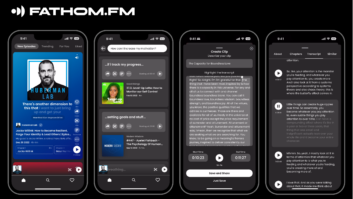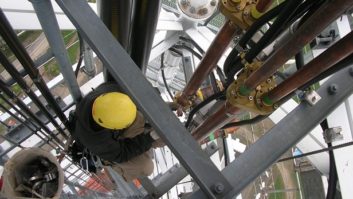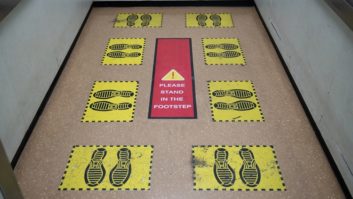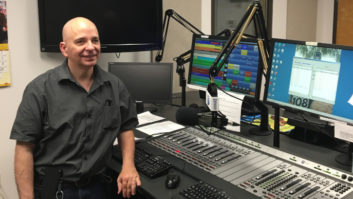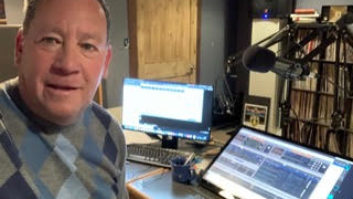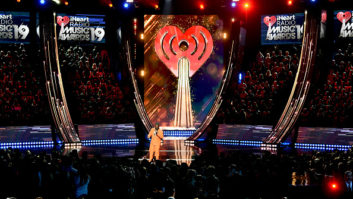The final Element
Aug 1, 2005 12:00 PM, By Doug Irwin
Fall is fast approaching, and with it for many engineers comes the chore of capital budgeting. You might be tasked with budgeting for an HD Radio installation next year. Last month I wrote about the trends in technology with respect to HD Radio-capable transmitters, but little was said about the antenna itself. This time we’ll examine some ideas and items to look for in the budgeting and planning process as they apply to FM and AM antennas.

WNNK, Harrisburg, PA, has an interleaved antenna system (upper antenna) mounted directly above a backup antenna.
How you decide to implement IBOC depends on the circumstances of your current transmitter site. Let’s take the example of a transmitter facility at which there is plenty of space on the tower that holds the current antenna. You could use a separate antenna for the planned HD Radio transmission. Keep in mind that the tower needs a space to support this additional antenna between 70 and 100 percent of the HAAT of the analog current antenna. The station also needs an STA from the FCC before the antenna is energized. The good news about the additional antenna, at least from a capital cost standpoint, is that the digital antenna can be a low-power type because the digital ERP will be 20dB below the analog ERP. The station can also use a smaller transmission line. Don’t build it too small, however, because it could be licensed as an auxiliary antenna for the analog transmission and it’s likely that you’ll want to have as high an analog ERP for that use as possible. Likewise, remember that if it is using an auxiliary, and if it is too close to the main antenna, the RF field may prevent it from being used during maintenance to the main antenna.
The proximity of the analog and digital (or main and aux) is also a concern for other reasons. Two antennas with broad patterns in the vertical plane (i.e. low-gain types) will not provide as much isolation from one another, necessitating a considerable expense on an isolator for the output of the IBOC transmitter. The isolator will have to be rated for the amount of forward power being run through it in the forward direction, and the termination will need to handle the amount of power that is expected to come back from the IBOC antenna. At least three manufacturers make high-power isolators: AFT in Germany, Channel Microwave (used by Shively) and EMR. Even if an isolator is not needed, consider the proximity of the antennas of neighboring stations; too much RF from one of them could generate intermodulation products in the output of the IBOC transmitter. A low-power bandpass filter can be installed to prevent this. All the major antenna manufacturers make these as well. (Not to dwell on the auxiliary antenna aspect, but make sure the filter is sized to handle the amount of power that will go through it if the new antenna is used as an aux for the analog transmission.)
The big four antenna manufacturers all make low power versions of their FM-band antennas. ERI has the LPX, the lower-power version of the rototiller. It also offers the 1105 series, which is for lower-power applications, and the 100 series made for LPFM. In most cases it will easily handle the input power needed for an IBOC project. Jampro offers the JLST for low-power applications and the JMPC (among others) for medium power. Shively makes the 6812 for lower-power applications and the 6813 for medium power. Dielectric makes the DCR-L for lower power applications and the DCR-H for medium power applications.
To the extent possible, you need to maintain the ratio of analog to digital at 20dB around the entire horizontal plane. So, if the current antenna is directional (or even optimized) you will likely want to match the digital antenna type with that of the analog antenna. Likewise, at least consider using the same gain in the digital antenna as is used in the analog antenna to keep the vertical plane pattern the same or at minimum similar.
Something old? Something new!

AM antenna systems require linear, broadband and balanced response, which are the same factors that applied to an AM stereo upgrade.
Perhaps it is time to replace the old antenna, and HD Radio is just the catalyst that your station needs to buy one. If you plan to continue using the tower space you already have, there are several options available.
An IBOC antenna interleaved inside the pre-existing analog antenna is a technology used by at least three antenna manufacturers. An interleaved antenna is basically a system comprised of two completely separate antennas fed by separate transmission lines, with the radiating elements for the HD Radio antenna installed on the same support structure between the radiating elements for the analog antenna. The necessary degree of isolation between the two antennas is achieved by the use of opposite circularity. Even though the IBOC bays will ultimately handle less power, Shively, for example, prefers to use the same type of bays for the IBOC that are used for the analog system. In this way the horizontal plane pattern of the IBOC antenna matches that of the analog. The number of bays of the IBOC antenna does not have to match the number of the analog antenna. Shively has gone as high as seven bays for the IBOC antenna. Dielectric also offers an interleaved antenna system (the HDR series). Dielectric says that it can use 14 bays on an interleaved system, and that it can retrofit an interleaved antenna with analog antennas made by other manufacturers. Jampro also offers interleaved systems, using the low-power version of the Penetrator as the IBOC elements.
ERI now offers the Lynx, a dual-input antenna. The analog and digital transmitters feed their own separate input on this system. With careful installation, more than 30dB of isolation between the analog and digital inputs can be achieved. The radiating elements are excited by the analog and digital signals, thus ensuring the same horizontal and vertical plane patterns.
A backup alternative
While a fixed, permanent auxiliary antenna is the most ideal, there may be reasons why it’s not practical for some stations. In addition, there may be times when a temporary backup is needed, particularly after a storm or when the location will be for a short term.
A single-bay backup antenna can be stored in a secure location and pressed into action when it is needed. This can be especially helpful to clusters in a region that can share the resource. It may be feasible to use a single bay from a retired antenna for this purpose.
If space or portability is a concern, Armstrong offers the FMA-2VBP portable antenna (shown here). This broadband antenna breaks apart for easy transport and sets up in moments. The antenna fits in a hard-shell shotgun case for shipping. Multiple-bay versions are also available.
Stations that use a multiple-element panel antenna, either singly or several through a combiner, should contact the antenna manufacturer for the modifications necessary to the system so that the panel antenna can also be driven with the IBOC RF signals.
If the tower holding the main antenna is crammed with other antennas and there is simply no possibility of adding a separate antenna, you may be compelled to stick with what you already have. That works fine, too. If you feed this single antenna with a high-level combined system, you will need an injector, which couples the IBOC carriers into the same transmission line that carries the analog RF to the antenna. Each of the big four can provide the injector. Dielectric makes several versions of its unit with power levels from 12kW to 70kW, and coupling factors of 10, 9 or 8dB. Custom coupling factors are also available. Shively makes five versions of its injector up to 40kW, with 10, 9, 8, 7 and 6dB of coupling. Jampro makes two versions of a 10dB coupler, a high-power one rated at 35kW analog and 10kW IBOC, and a medium-power one rated for 10kW analog and 3.5kW IBOC. ERI makes four versions of a 10dB coupler; 12kW max with a 1?” connector and 30kW with 3?” connectors. The higher-power version will handle up to 80kW of analog RF with a 6?” connector.
A shift in the band
Planning for an AM HD Radio system is potentially much more of a minefield than planning one for FM. A critical aspect of the performance of the antenna system is the impedance bandwidth of the antenna as seen by the transmitter. If the VSWR seen by the transmitter in the upper sideband region is too different than that in the lower sideband region, the net result will be higher bit-error radio (BER) at the receiver. The first step in the plan is to hire a consultant who is experienced with the characteristics of AM antenna systems, especially with respect to AM IBOC. He can evaluate the antenna system and subsequently make recommendations on its modifications should any be necessary. Several established companies, such as Kintronic Labs, LBA or Phasetek could then be used for the design and construction of new building blocks of the system such as the phasor in the event that the antenna is directional and the antenna-tuning units.
Research and planning are the keys to accurate budgeting. Do your homework now, and get an early start so that there is plenty of time to mull your decisions before finalizing them. Your antenna is your final link in the broadcast chain between you and your listeners, and as such its importance cannot be overemphasized.
Resource Guide
A list of some manufacturers and dealers of antennas and accessories
Isolators
AFT
301-670-2833
www.aftgmbh.de
Channel Microwave
805-482-7280
www.channelmicrowave.com
EMR Corporation
623-581-2875
www.emrcorp.com
Antennas
Antenna Specialists
440-349-8400
www.antenna.com
Armstrong Transmitter
315-673-1269
www.armstrongtx.com
Bext
619-239-8462
www.bext.com
Crossed Field Antennas
860-676-0051
Dielectric Communications
800-341-9678
www.dielectric.com
ERI-Electronics Research
812-925-6000
www.ERIinc.com
Harris
800-622-0022
www.broadcast.harris.com
Jampro Antennas
916-383-1177
www.jampro.com
Kathrein, Scala Division
541-779-6500
www.kathrein-scala.com
OMB America
800-662-4872
www.omb.com
Propagation Systems
814-472-5540
www.psibroadcast.com
RFS Broadcast
877-737 9675
www.rfsworld.com
Shively Labs
888-SHIVELY
www.shively.com
Superior Broadcast Products
800-279-3326
www.superiorbroadcast.com
SWR
800-762-7743
www.swr-rf.com
Valcom Limited
519-824-3220
www.valcom-guelph.com
AM Systems
Kintronic Labs
423-878-3141
www.kintronic.com
LBA Technology
800-522-4464
www.lbagroup.com
Phasetek
215-536-6648
Irwin is director of engineering for Clear Channel Radio Seattle.






